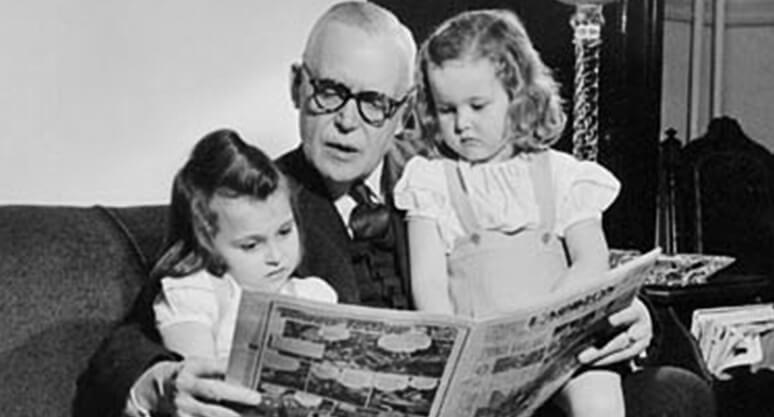 The St-Laurent government’s leadership modernized the idea of Canada in its support of new programs and international relations, writes Patrice Dutil.
The St-Laurent government’s leadership modernized the idea of Canada in its support of new programs and international relations, writes Patrice Dutil.
By Patrice Dutil, October 29, 2020
Scanning the landscape of political reputations, the journalist Bruce Hutchison wrote that “no finer human being ever governed Canada and none has been so thoroughly misunderstood as Louis St-Laurent.” This was in 1964, seven years after the old Liberal leader had retired from politics. That judgment still stands.
St-Laurent was born in Compton in 1882, studied law at Laval University and plunged into his profession, rising to become a leading barrister in Canada. Mackenzie King approached him to join the cabinet in November 1941; he said yes the day after Japan bombed Pearl Harbour. He was almost 60 years old (which in those days was old—the life expectancy for a man born at the same time was 40).
But he was young in spirit. Within seven years, in November 1948, he reached the top of Disraeli’s proverbial “greasy pole” with the driest hands possible. In the spring of 1949, at age 67, he led the Liberals to their greatest victory ever. In 1957, most thought Canada’s best-known great-grandfather would win a third time and lead Liberals to a third consecutive decade in power. The Liberals won the popular vote but lost the election. John Diefenbaker formed a minority government. Louis St-Laurent was now 75 years old (and would live to the ripe old age of 91).
Louis St-Laurent’s time as prime minister left a number of leadership lessons. Some have been retained, others not.
- Age and Experience Matter. St-Laurent came to electoral politics late in life, and became prime minister at an age far older than any other person, before or since. Age gave him an asset: he had nothing to prove. He had earned the respect of his peers and of the population.
- Know Yourself. St-Laurent believed in what he knew and he said what he believed. He was, like many people who rose to power in the West in the 1940s and 1950s—Adenauer, Attlee, Ben-Gurion, De Gaulle, Eisenhower, Marshall, Masaryk, Truman—a man who had seen too much grief and wanted a better world.
- Attract and Unleash the best Cabinet Members. The key about St-Laurent was that he was not afraid to have top talent around him: Lester Pearson, C.D. Howe, Paul Martin Sr., Jean Lesage, Jack Pickersgill to name but the best known. The occasional threats to resign coming from ministers were met with a stony silence and the assurance that government could operate quite well without them.
- Seek the Best Leadership of the Public Service. St-Laurent knew how to manage competency. Good, dedicated people mattered to him and he mattered to them. As simple as it sounds, this can be most difficult to accomplish. John Diefenbaker inherited the same team of mandarins, and simply could not run his administration effectively.
- Be Idealistic. St-Laurent was quite happy to challenge conventions. He openly talked about “values” in guiding Canada’s foreign policy. He was anti-communist, for sure, but he was also a humanist and an ardent believer in peace. St-Laurent reimagined the Commonwealth of Nations, actively promoted international aid by joining the Columbo Plan, and promoted Canada as a voice—and an enabler—of peace long before the Suez crisis in 1956.
- Walk the Talk. Canada joined NATO a few months after he became prime minister because, for him, internationalism means shouldering responsibility. St-Laurent believed that Canada should have a strong military, and showed that he meant it in expanding it rapidly during the 1950s. St-Laurent had an aircraft carrier built, the HMCS Bonaventure, and became the father of the Canadian Aerospace industry when his government invested in the developing the Avro-Arrow, a supersonic jet fighter. It was during his time in government that Canada dotted its northern landscape with three necklaces of distant early warning (DEW) stations.
- Build Infrastructure. St-Laurent oversaw a massive spending increase, taking on large infrastructure projects such as the St. Lawrence Seaway, the Trans-Canada Highway, the Canso Causeway in Nova Scotia and, not least, the transcontinental gas pipeline from Alberta to central Canada.
- Build up Provinces and Regions. St-Laurent was willing to see the federal government involved in areas of provincial jurisdiction to help the regions. He innovated in university funding and hospital funding, Not least, he introduced equalization payments to ensure that all Canadians, no matter where they live, receive adequate and comparable government support.
- Help the Poor. The St-Laurent government introduced a variety of poverty reduction programs for the elderly, the disabled and the long-term unemployed. He helped the Inuit battle tuberculosis in the North. The St-Laurent government introduced universal pensions for people over 70 years of age, and over 65 for people in demonstrable need. To help people save for retirement, he spearheaded the creation of the RRSP. He also introduced hospitalization insurance and equalization payments.
- Help Canada Define Itself. St-Laurent’s government oversaw a massive inflow of immigrants. He believed that culture mattered. and was willing to invest considerable political capital to crusade for a variety of new national symbols. He Canadianized the Governor General and created the Canada Council, to give but two quick examples.
St-Laurent brought something new to government: an almost perfect mix of idealism and realism. On almost every issue it touched, his government modernized the idea of Canada, either in its support of new programs or in its international relations. It was, against all expectations, St-Laurent who proved to be a key agent of modernity in this country. Many of the things he did while in office continue to shape Canadian politics today—pipelines, defence, the place of Canadian culture, the impact of immigration, the nature of equalization payments, the imperatives of dealing with the North, to name but a few— are still with us and Canadians today live with the ambitions that St-Laurent first crafted. Yet no one would call themselves a “St-Laurent kind of politician,” or a “St-Laurent Liberal.” That is too bad: Canadians believed him and supported his priorities. His leadership lessons should resonate to this day.
Patrice Dutil is a professor of political science and public administration at Ryerson University. He is the Editor of The Unexpected Louis St-Laurent: Politics and Policies for a Modern Canada (University of British Columbia Press).





